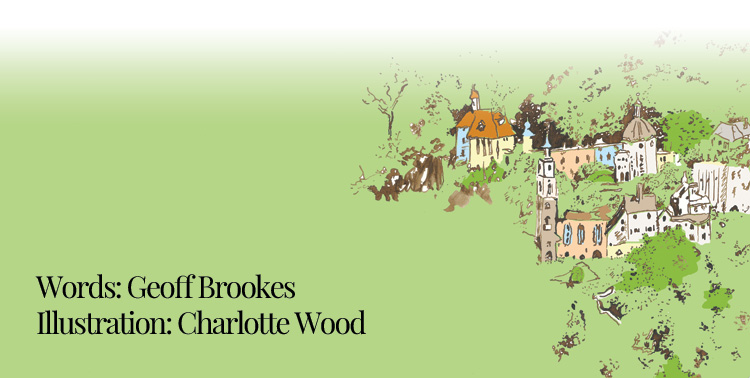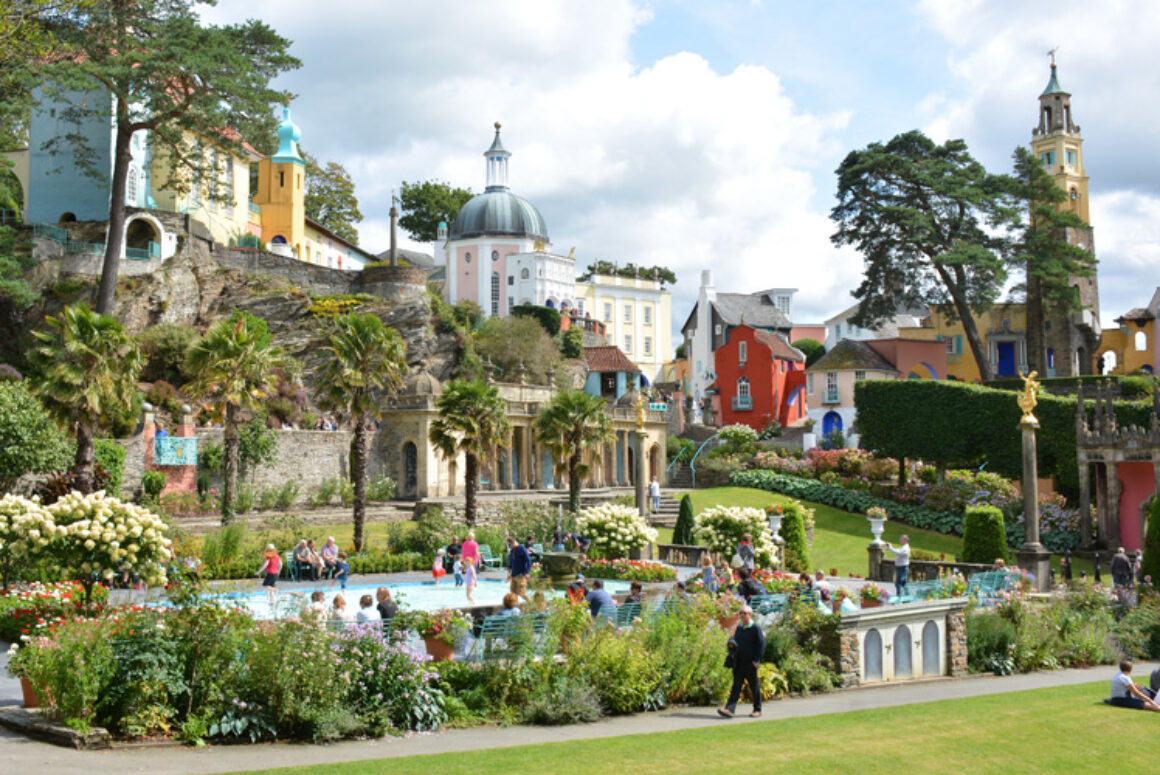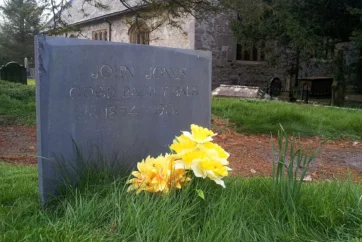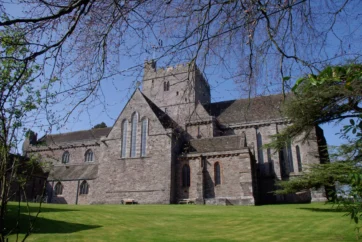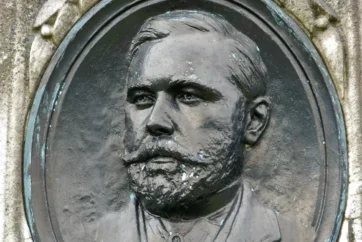![]()
Geoff Brookes tells the tale of Portmerion and it’s creator, Bertram Clough Williams-Ellis.
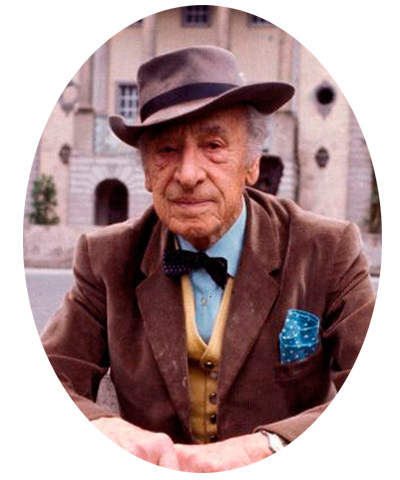
There is no gravestone for Clough Williams-Ellis. His ashes were launched into the night sky on a marine rocket as part of a New Year’s Eve firework display 20 years after his death in April 1978. Then he drifted gently down into the estuary that runs alongside his creation, the wonderful village of Portmeirion. So the best I can offer you is this fine, but mossy 17th century lion. It was a ninetieth birthday present from his friends and now rests majestically alongside the path behind the Gothic Pavilion. Please go and look at it, for his unique creation is one of the gems of Wales.
He was born in Northamptonshire in 1883 but the family moved back to north Wales when he was four. He always claimed direct descent from Owain Gwynedd, the first Prince of Wales and certainly he was aware of his Welsh heritage. He went to Cambridge University but never graduated, choosing instead to become an architect, originally designing small residential buildings. He inherited a small country house from his father, Plas Brondanw, spending the rest of his life on an extended renovation project, and indeed rebuilding it after a fire in 1951.
Of course his privileged background enabled him to indulge his ideas in a way that someone else could not. He wrote about himself that he had a “weakness for splendour and display” which would be a bit of a curse if you didn’t have the money. It enabled him to buy his very own private peninsular and build his own village on the edge of Snowdonia. He bought an abandoned estate at Aber Ia, a place with a long history, where Castell Deudraeth was once allegedly owned by Gruffudd ap Cynan, the eleventh century king of Gwynedd.
It was a sheltered site, full of specimen trees thriving in the peninsula’s own mild micro-climate. When he acquired the site in 1925 for less than £5,000 he described it as “a neglected wilderness.”
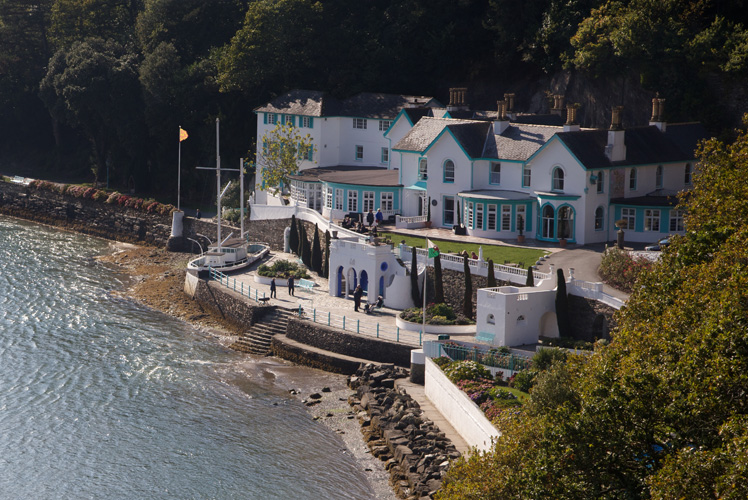
But he was a man with a plan. Details of his Portmeirion project first appeared in the press in January 1926 when The Architect’s Journal carried photographs of scale models of his village and by 1939 its most significant buildings had been completed. The second phase, the introduction of a mass of interesting details, was completed between 1954 and 1973, in time for Clough’s ninetieth birthday and of course, that gift-wrapped lion.
Of course he knew that he had to find a way of funding his elaborate project and the obvious way was as a tourist attraction and a hotel. The village now receives in excess of 250,000 visitors every year with as many as 3,000 visitors a day. It is an important contribution to the economy of the area.
He fought for the countryside and campaigned for the environment, advocating the creation of National Parks like Snowdonia and all the time he worked as an architect always returning to Portmeirion. The village was a hobby and an indulgence that gave Clough Williams Ellis huge pleasure and it has continued to do so for visitors ever since.
There is nowhere like it at all, it’s a real mixture of illusion and reality. Of course there is much about Portmeirion that is obviously false. There are windows which, when you get close, are actually just painted on to walls. There are statues that are merely cut-outs in metal plate, giving the impression of inhabiting three dimensions, whilst firmly living in only two. One of the houses, The Unicorn, has a Georgian front that hides a flat-roofed bungalow. A ship by the hotel isn’t a ship at all. What was once the Amis Reunis is now filled with concrete, an extension continuing the perfect curve of the quayside. Things are not what they seem in Portmeirion and that is unquestionably one of its charms.
It is a constantly entertaining place and there is always something to look at. It was built deliberately for views, with a concern for how things relate to each other and for how the scenes change as you move through a three dimensional work of art.
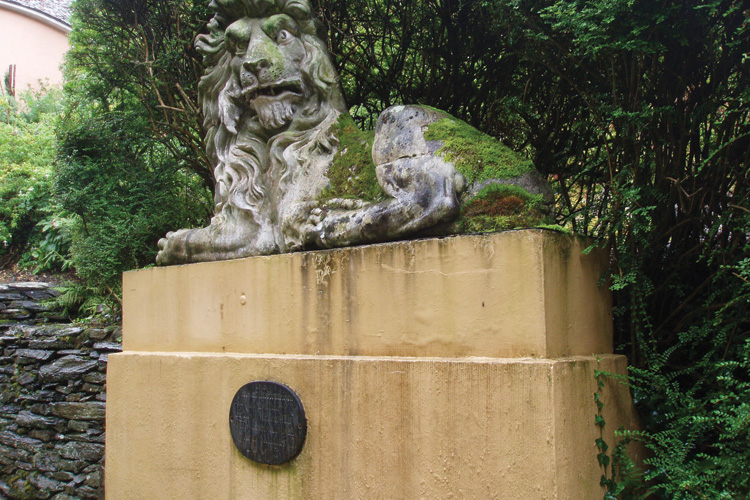
Of course it is impossible to write about Portmeirion without mentioning The Prisoner. The celebrated and enigmatic series that was so much a part of the late sixties was filmed here. It was the perfect marriage between style and substance. There is a sense in Portmeirion of being transported into another place and this was ideal for a series based upon deliberate disorientation. The programme brought together a bizarre mixture of images to create a dream-like environment. You can watch The Prisoner on the television in the hotel, which shows regular episodes, and you are transported back in time. Then you go outside and what you have seen is still there, in the same bright colours. For that moment you have stepped through time. It is a window into the past, yes. But a real window? Or is it a painted one? Reality in Portmeirion is distorted – always. Dimensions shift. Perspectives change. When you make the climb up to the viewing point in the gazebo and you look down, what you see is apparently a toy village, coloured in pastel shades.
One of the great triumphs of Portmeirion is that not everything is new build. Clough Williams-Ellis established his village as a home for distressed and unwanted features. He described Portmeirion rather more cleverly as a “home for fallen buildings”. It was his skill and vision that brought all this eclectic collection together into a coherent form. He was a snapper-up of unconsidered trifles and turned them into something else.
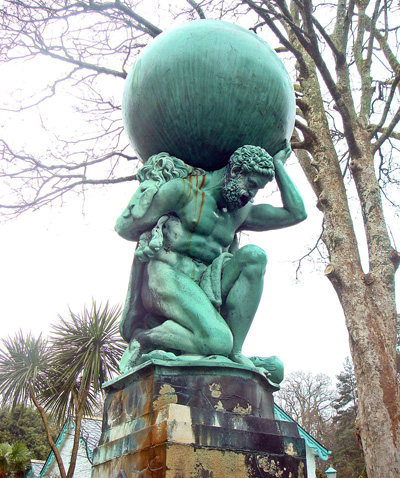
There is the turret clock from a demolished London brewery in the Bell Tower. There are mermaid panels in the gazebo from the Seaman’s Home in Liverpool. The town hall was built from salvaged material from Emrall Hall in Flintshire. The library in the main hotel came from the Great Exhibition of 1851. The Gloriette is built from a colonnade rescued from Hooton Hall in Cheshire. The Bristol Colonnade was dismantled and transported from Arnos Court. The porch of the Pantheon is in fact a vast fireplace from Dawpool in Cheshire. The list goes on. It is fascinating to see how all these different elements have been brought together into something completely harmonious. This is his triumph, because in the hands of someone else, these architectural orphans would not have united so naturally. There is a controlling intelligence here, re-enforced by a sense of style and fun. This can be seen most clearly in the details that are a constant pleasure – the copper dolphins, the statue of Hercules brought down on the back of a truck from Aberdeen, the painted statue of St. Peter on the balcony of the Toll House, the Burmese dancing figures in the Piazza, the bust of Shakespeare on the loggia connecting Dolphin to Government House. Just below the shop that sells all manner of The Prisoner memorabilia, you can see the statue of The Buddha that featured in Ingrid Bergman’s The Inn of the Sixth Happiness which was filmed locally.
Portmeirion – a story in stone – and lots of other materials too.
Many architects are dismissive of what Clough Williams-Ellis achieved. They regard it as false and artificial, out of tune with its surroundings. In a way though that is exactly the point. It has been deliberately created as somewhere unique, a fantasy, a village which is Italian, Cornish and Norwegian all at the same time. Yes it is Disneyland. But Disneyland for grown-ups, built with intelligence and style. He believed that everyone should be able to experience a “taste of lavishness, gaiety and cultivated design.” In such a place, away from your other life, you can lose yourself. Perhaps that is why celebrated writers have always come to Portmeirion – George Bernard Shaw, H.G. Wells, Bertrand Russell. Noel Coward wrote Blithe Spirit here in two weeks in 1941, staying in Upper Fountain. Regular readers will not be surprised to learn that when I stayed in the same suite I struggled to write a postcard. I had eaten too well in the restaurant I think.
